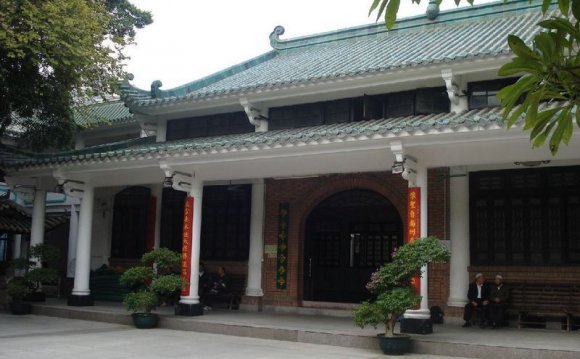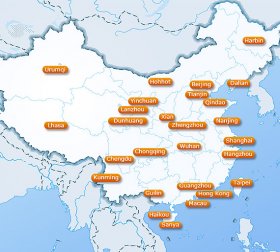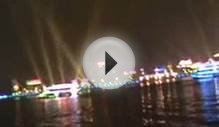
Tip: Click the city names to see the weather forecast for the coming three days.

Introduction to China Climate
In China, a vast land spanning many degrees of latitude with complicated terrain, climate varies radically. China has a variety of temperature and rainfall zones, including continental monsoon areas. In winter most areas become cold and dry, in summer hot and rainy.
Five Temperature Zones
Temperatures vary a great deal. Influenced by latitude and monsoon activities, in winter, an isotherm of zero degrees traverses the Huaihe River-Qinling Mountain-southeast Qinghai-Tibet Plateau. Areas north of the isotherm have temperatures below zero degrees and south of it, above zero. Mohe in Heilongjiang can hit an average of 30 degrees centigrade below zero, while the temperature of Sanya in Hainan Province is above 20 degrees. In summer, most of areas are above 20 degrees centigrade despite the high Qinghai-Tibet Plateau and other mountains such as Tianshan. Among these hot places, Turpan Basin in Xinjiang is the center for intense heat at 32 centigrade on average.
Cold-Temperate Zone: north part of Heilongjiang Province and Inner Mongolia (Representative city: Harbin)
Mid-Temperate Zone: Jilin, northern Xinjiang, and most of Heilongjiang, Liaoning, and Inner Mongolia (Representative cities: Beijing, Shenyang, Dalian, Urumqi, Hohhot, Dunhuang, Lanzhou)
Warm-Temperate Zone: area of the middle and lower reaches of the Yellow River, Shandong, Shanxi, Shaanxi, and Hebei Province (Representative cities: Xian, Taiyuan, Luoyang, Jinan, Qingdao, Zhengzhou)
Subtropical Zone: South of isotherm of Qinling Mountain-Huaihe River, east of Qinghai-Tibet Plateau (Representative cities: Shanghai, Guangzhou, Hong Kong, Macau, Guilin, Hangzhou, Suzhou, Kunming, Dali, Lijiang, Chengdu)
Tropical Zone: Hainan province, southern Taiwan, Guangdong, and Yunnan Province (Representative cities: Haikou, Sanya)
Plateau Climate Zone: Qinghai-Tibet Plateau (Representative city: Lhasa)
Precipitation
Precipitation in China is basically regular each year. From the spatial angle, the distribution shows that the rainfall is increasing from southeast to northwest, because the eastern seashores are influenced more than inland areas by the summer monsoon. In the place with the most rainfall, Huoshaoliao in Taipei, the average annual precipitation can reach over 6, 000mm. The rainy seasons are mainly May to September. In some areas, especially in the dry northwest, changes in precipitation every year are greater than in the coastal area. Based on precipitation, the area divides into four parts: wet area, semi-wet area, semi-dry area and dry area.
Monsoon
In summer, a southeast monsoon from the western Pacific Ocean and a southwest monsoon from the equatorial Indian Ocean blow onto the Chinese mainland. These monsoons are the main cause of rainfall. Starting in April and May, the summer rainy season monsoons hit the southern provinces of Guangdong, Guangxi, and Hainan. In June, the rains blow northward, and South China gets more rainfall with the poetic name, plum-rain weather, since this is the moment when plums mellow. North part of the country greets its rainy season in July and August, says farewell in September; gradually in October the summer monsoons retreat from Chinese land. Eastern China experiences many climate changes, while the northwest area is a non-monsoon region.
Air Pollution
With vast territory, China is renowned for its diversity of climates and regions. However, besides the world climate change, the rapid development of economy in the past 30 years resulted in deterioration of air quality. Many cities have been adversely affected by hazy weather since the beginning of 2013, especially those in the central and eastern area.
World Climate Change
As a common phenomenon, global warming now is no longer strange to everyone. It is worth to mention that the damage caused by the climate change, from natural disasters to food chain rupture, is involved in all aspects of the human existence.
INTERESTING VIDEO












